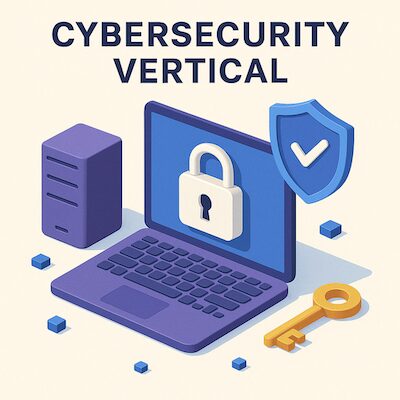What is the meaning of the Cybersecurity Vertical?
The Cybersecurity vertical refers to the **industry segment focused on protecting digital systems, networks, data, and infrastructure from cyber threats, breaches, and unauthorized access**. This vertical includes a wide range of companies, technologies, services, and frameworks designed to safeguard individuals, businesses, and governments from growing cyber risks. Cybersecurity is essential in today’s interconnected world, where data integrity, privacy, and resilience are critical across all sectors.
What does the Cybersecurity Vertical include?
The Cybersecurity vertical spans multiple technologies and service categories designed to address different layers of digital security. These include:
- Network Security: Firewalls, intrusion detection/prevention systems (IDS/IPS), and VPNs
- Endpoint Security: Antivirus, anti-malware, and mobile device management (MDM)
- Cloud Security: Tools for securing cloud-based infrastructure and SaaS platforms
- Identity & Access Management (IAM): Multi-factor authentication, single sign-on, and role-based access controls
- Application Security: Secure coding practices, vulnerability scanning, and penetration testing
- Data Protection & Encryption: Technologies to protect sensitive data at rest and in transit
- Security Operations & Threat Intelligence: SIEM platforms, SOC teams, and real-time monitoring
Why is the Cybersecurity Vertical important?
Cybersecurity is a **critical enabler of digital trust, operational continuity, and regulatory compliance**. The vertical is essential because:
- Cyberattacks are increasing: Ransomware, phishing, and data breaches affect organizations of all sizes
- Data is a core asset: Personal, financial, and intellectual property must be protected
- Regulations demand it: Laws like GDPR, HIPAA, and CCPA require robust security practices
- Digital transformation is expanding: As businesses migrate to the cloud and remote work, security risks grow
How do companies operate in the Cybersecurity Vertical?
Companies in this vertical operate as **technology vendors, service providers, consultants, or platform integrators**. Common roles include:
- Software developers: Building cybersecurity tools such as antivirus, endpoint protection, or authentication platforms
- Managed Security Service Providers (MSSPs): Offering outsourced 24/7 monitoring and threat response
- Consulting firms: Conducting risk assessments, compliance audits, and security architecture reviews
- Startups and R&D labs: Innovating with AI, blockchain, or quantum-safe encryption technologies
What challenges does the Cybersecurity Vertical face?
While rapidly growing, the cybersecurity industry faces several critical challenges:
- Talent shortage: A global lack of skilled cybersecurity professionals
- Complex threat landscape: Constant evolution of new attack vectors and tactics
- Tool fragmentation: Organizations may use dozens of security tools that lack integration
- User behavior: Human error remains a leading cause of breaches
- Budget constraints: Especially among small-to-medium businesses that are also targets
Which countries are leaders in Cybersecurity and why?
Several countries have emerged as global leaders in cybersecurity innovation, resilience, and policy development. Key examples include:
- United States: Home to major cybersecurity companies, government initiatives like CISA, and significant military-grade cyber defense capabilities. U.S. leadership stems from massive investments in R&D, the private sector’s strength, and global collaboration on cyber policies.
- Israel: Known as the “Start-up Nation,” Israel has one of the world’s most advanced cybersecurity ecosystems, driven by elite military training programs (e.g., Unit 8200) and a vibrant innovation culture. The country is a leader in threat intelligence, encryption, and cyber-defense technologies.
- Estonia: Estonia is often cited as a model for national cybersecurity after its experience with cyberattacks in 2007. Estonia has built a “digital-first” government, with secure e-residency programs, blockchain-backed systems, and hosts NATO’s Cooperative Cyber Defence Centre of Excellence (CCDCOE). Its proactive policies, digital society, and investment in cyber resilience make it a standout in Europe and globally.
- United Kingdom: The UK has developed strong cybersecurity leadership through initiatives like the National Cyber Security Centre (NCSC) and supports innovation through cyber hubs and incubators. It plays a key role in international cyber diplomacy and standards setting.
- Singapore: Singapore leads in Asia due to its forward-thinking cybersecurity strategy, government investments, and hosting major global cybersecurity events. Its Smart Nation initiative incorporates cybersecurity by design across all major infrastructure projects.
Can you give an example of the Cybersecurity Vertical in action?
A financial services firm implements a **zero-trust security model** that includes multifactor authentication, encrypted communication channels, and continuous behavioral monitoring to protect customer data. They partner with a cybersecurity platform to run real-time threat detection using AI and also hire a third-party vendor to conduct penetration testing every quarter. Together, these tools and services represent how the cybersecurity vertical supports proactive defense, regulatory compliance, and secure digital transformation.



